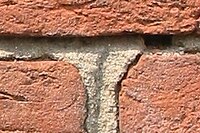
Photo from wikipedia
Abstract Nowadays, the Polyethylene Terephthalate (PET) bottle, which is a post-consumer product, has generated a strong interest in the environmental consequences that surround it, and a suitable alternative is to… Click to show full abstract
Abstract Nowadays, the Polyethylene Terephthalate (PET) bottle, which is a post-consumer product, has generated a strong interest in the environmental consequences that surround it, and a suitable alternative is to incorporate it in mortar and concrete. Therefore, the aim of this research was to evaluate rendering mortars based on Portland cement/hydrated lime produced with PET bottle waste, used to partially replace 2.5%, 5%, 10%, 15% and 20% (by volume) of the fine aggregate in order to investigate the effectiveness and the improvement of these materials. The experimental program was performed in the fresh and hardened states, to determine flowability, fresh and hardened densities, air content, apparent porosity, water absorption by immersion, water retention, water absorption by capillarity, drying, water vapor permeability, ultrasonic wave velocity, and dynamic modulus of elasticity. Also, scanning electron microscopy (SEM) was performed. Generally, the results showed that the incorporation of PET significantly changed some properties, as verified by statistical analysis. Remarkable results from the incorporation of PET into rendering mortars based on Portland cement/hydrated lime are: close to 90% similarity of water retention between the mixtures, water absorption due to capillarity of M2.5 at 1.89 kg/(m2·min1/2), drying of the M15 specimen at 5.85 kg/m2, water vapor permeability of the M20 at 41.15 (ng/(m·s·Pa)) and the dynamic modulus of elasticity of M2.5 at 3.57 GPa. These replacements showed the possibility of mitigating the environmental impacts that the PET bottle life cycle can have and the extraction of the fine aggregate, promoting another possibility of disposal for this waste.
Journal Title: Journal of Building Engineering
Year Published: 2020
Link to full text (if available)
Share on Social Media: Sign Up to like & get
recommendations!